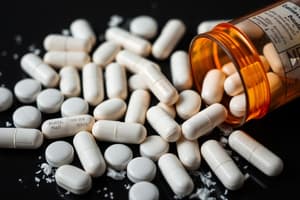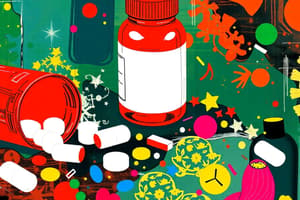Podcast
Questions and Answers
What is one of the main effects of stimulants on the nervous system?
What is one of the main effects of stimulants on the nervous system?
- Boost alertness and energy (correct)
- Induce sedation and relaxation
- Cause euphoria and hallucinations
- Decrease brain function
Which statement about the addiction potential of depressants is accurate?
Which statement about the addiction potential of depressants is accurate?
- They pose a high risk for developing tolerance. (correct)
- They have a low potential for addiction.
- They do not lead to dependency.
- They are always safe for long-term use.
Which medical condition is commonly treated with stimulants?
Which medical condition is commonly treated with stimulants?
- Anxiety disorders
- Attention Deficit Hyperactivity Disorder (ADHD) (correct)
- Chronic pain
- Sleep disorders
What classification do many stimulants fall under in the U.S. legal system?
What classification do many stimulants fall under in the U.S. legal system?
What is a common withdrawal symptom associated with depressants?
What is a common withdrawal symptom associated with depressants?
What is the addiction potential of inhalants?
What is the addiction potential of inhalants?
Which of the following inhalants has medical usage?
Which of the following inhalants has medical usage?
How are many depressants legally classified in the U.S.?
How are many depressants legally classified in the U.S.?
How do stimulants impact heart rate and blood pressure?
How do stimulants impact heart rate and blood pressure?
What are common withdrawal symptoms associated with depressants?
What are common withdrawal symptoms associated with depressants?
What is a notable medical use for inhalants?
What is a notable medical use for inhalants?
Discuss the addiction potential of stimulants.
Discuss the addiction potential of stimulants.
What kind of regulatory category do many stimulants fall under?
What kind of regulatory category do many stimulants fall under?
Which withdrawal symptoms are commonly seen in stimulant use?
Which withdrawal symptoms are commonly seen in stimulant use?
What effects do depressants have on brain activity?
What effects do depressants have on brain activity?
What is the legal restriction surrounding the use of depressants in the U.S.?
What is the legal restriction surrounding the use of depressants in the U.S.?
What is the primary function of antidepressants?
What is the primary function of antidepressants?
Which class of antidepressants specifically targets serotonin reuptake?
Which class of antidepressants specifically targets serotonin reuptake?
What is a common side effect associated with typical antipsychotics?
What is a common side effect associated with typical antipsychotics?
How do atypical antipsychotics differ from typical antipsychotics in their mechanism of action?
How do atypical antipsychotics differ from typical antipsychotics in their mechanism of action?
Which of the following is considered a rare side effect of antidepressants?
Which of the following is considered a rare side effect of antidepressants?
What is the primary goal of psychopharmacology?
What is the primary goal of psychopharmacology?
Which of the following is NOT a consideration in effective psychopharmacological treatment?
Which of the following is NOT a consideration in effective psychopharmacological treatment?
Which medication type is primarily used to manage severe depression with psychotic features?
Which medication type is primarily used to manage severe depression with psychotic features?
Flashcards are hidden until you start studying
Study Notes
Stimulants
-
Effects On The Nervous System:
- Increase levels of dopamine and norepinephrine.
- Boost alertness, attention, and energy.
- Can elevate heart rate and blood pressure.
-
Addiction Potential:
- High potential for addiction due to rapid reinforcement.
- Risk of tolerance, leading to increased dosages.
-
Medical Uses:
- Treatment of Attention Deficit Hyperactivity Disorder (ADHD) (e.g., Adderall, Ritalin).
- Certain antidepressants (e.g., bupropion).
-
Legal Status And Regulations:
- Many are classified as Schedule II substances in the U.S.
- Legal for medical use with prescription; illegal use is criminalized.
-
Withdrawal Symptoms:
- Fatigue, depression, irritability.
- Increased appetite, sleep disturbances.
Depressants
-
Effects On The Nervous System:
- Reduce neuronal activity and decrease brain function.
- Induce relaxation, sedation, and decreased anxiety.
-
Addiction Potential:
- Moderate to high potential for addiction.
- Risk of developing tolerance and dependency.
-
Medical Uses:
- Treatment of anxiety and sleep disorders (e.g., benzodiazepines, barbiturates).
- Anesthesia (e.g., propofol).
-
Legal Status And Regulations:
- Many are Schedule IV substances (e.g., benzodiazepines) in the U.S.
- Legally prescribed for medical conditions, but regulated.
-
Withdrawal Symptoms:
- Anxiety, insomnia, tremors.
- Severe cases may lead to seizures or delirium.
Inhalants
-
Effects On The Nervous System:
- Rapidly depress the central nervous system.
- Can cause euphoria, dizziness, and hallucinations.
-
Addiction Potential:
- Moderate addiction potential; users can develop a tolerance.
- Risk of psychological dependence.
-
Medical Uses:
- Some are used medically as anesthetics (e.g., nitrous oxide).
- Limited approved usage due to safety concerns.
-
Legal Status And Regulations:
- Many inhalants are legal household products; misuse is illegal.
- Regulations focus on preventing abuse rather than outright bans.
-
Withdrawal Symptoms:
- Irritability, insomnia, cravings.
- In severe cases, withdrawal can lead to neurological symptoms.
Stimulants
- Increase dopamine and norepinephrine levels in the brain.
- Boost alertness, attention, and energy.
- Elevate heart rate and blood pressure.
- High potential for addiction.
- Risk of developing tolerance, leading to increased dosages.
- Used to treat ADHD and as certain antidepressants.
- Many are classified as Schedule II substances in the U.S.
- Legal for medical use with prescription, but illegal use is criminalized.
- Withdrawal symptoms include fatigue, depression, irritability, increased appetite, and sleep disturbances.
Depressants
- Reduce neuronal activity and decrease brain function.
- Induce relaxation, sedation, and decreased anxiety.
- Moderate to high potential for addiction.
- Risk of developing tolerance and dependency.
- Used to treat anxiety and sleep disorders, and as anesthetics.
- Many are Schedule IV substances in the U.S.
- Legally prescribed for medical conditions, but regulated.
- Withdrawal symptoms include anxiety, insomnia, tremors, and in severe cases seizures or delirium.
Inhalants
- Rapidly depress the central nervous system.
- Can cause euphoria, dizziness, and hallucinations.
- Moderate addiction potential.
- Risk of psychological dependence.
- Some are used medically as anesthetics.
- Limited approved usage due to safety concerns.
- Many are legal household products, but misuse is illegal.
- Regulations focus on preventing abuse rather than outright bans.
- Withdrawal symptoms include irritability, insomnia, cravings, and in severe cases neurological symptoms.
Stimulants
- Increase neurotransmitter activity, including dopamine and norepinephrine.
- Enhance alertness, energy, and focus.
- Stimulants can elevate heart rate and blood pressure.
- High potential for dependence and addiction, exemplified by cocaine and amphetamines.
- Tolerance develops, increasing required dosage to achieve the desired effect.
- Medical applications include treating ADHD with medications like methylphenidate and amphetamines.
- Stimulants have anorectic properties, suppressing appetite.
- Withdrawal symptoms manifest as fatigue, depression, and increased appetite.
- Intense cravings for the substance characterize withdrawal.
- Classified as Schedule II controlled substances in many jurisdictions, necessitating stringent prescription and distribution regulations.
Depressants
- Depressants reduce brain activity, inducing sedation and relaxation.
- Inhibition of neurotransmitters, particularly GABA, contributes to reduced anxiety.
- Moderate to high potential for abuse, as seen with benzodiazepines and alcohol.
- Dependence can manifest physically and psychologically.
- Medical uses include treating anxiety, insomnia, and seizures.
- Anesthesia during surgical procedures relies on depressants.
- Withdrawal symptoms encompass anxiety, insomnia, seizures, and tremors.
- In severe cases, delirium, especially during alcohol withdrawal, can occur.
- Generally legal, though most require prescriptions.
- In the United States, benzodiazepines are classified as Schedule IV controlled substances.
Inhalants
- Inhalants produce short-term euphoria due to rapid delivery of chemicals to the brain.
- Effects include dizziness, impaired judgment, and altered sensory perception.
- Dependence potential ranges from low to moderate, often leading to habitual use.
- The intense yet ephemeral high can encourage repeated use.
- Limited medical uses exist, such as anesthetics or specific medical procedures.
- Some formulations, like nitrous oxide, find medical applications.
- Withdrawal symptoms include headaches, nausea, and irritability.
- Cravings and withdrawal effects are less prevalent compared to stimulants and depressants.
- Generally legal for household use; however, specific substances have restrictions.
- Substance abuse laws primarily focus on inhalant misuse rather than legal use.
Antidepressants
- Function: Treat depression, anxiety, and some personality disorders
- Classes:
- SSRIs (Selective Serotonin Reuptake Inhibitors): Increase serotonin levels in the brain (e.g., fluoxetine, sertraline)
- SNRIs (Serotonin-Norepinephrine Reuptake Inhibitors): Increase serotonin and norepinephrine levels (e.g., venlafaxine, duloxetine)
- Tricyclic Antidepressants (TCAs): Block the reuptake of serotonin and norepinephrine (e.g., amitriptyline, nortriptyline)
- MAOIs (Monoamine Oxidase Inhibitors): Inhibit the breakdown of neurotransmitters, increasing their levels (e.g., phenelzine, tranylcypromine)
Antipsychotics
- Function: Manage psychosis, including schizophrenia, bipolar disorder, and severe depression with psychotic features
- Types:
- Typical Antipsychotics: Block dopamine receptors (e.g., haloperidol, chlorpromazine)
- Atypical Antipsychotics: Act on a broader range of receptors, including serotonin and dopamine (e.g., risperidone, olanzapine)
Side Effects
- Antidepressants:
- Common: Nausea, weight gain, insomnia, sexual dysfunction
- Rare: Increased suicidal thoughts in adolescents
- Antipsychotics:
- Typical: Extrapyramidal symptoms (tremors, rigidity), tardive dyskinesia, sedation
- Atypical: Metabolic syndrome (weight gain, diabetes risk), agranulocytosis (low white blood cell count)
Psychopharmacology
- Definition: The study of how medications affect mood, behavior, and mental state.
- Goals:
- Symptom relief: Achieve remission of mental disorder symptoms
- Improve quality of life: Enhance overall functioning and well-being
- Maintenance therapy: Long-term treatment to prevent relapse in chronic conditions
- Considerations:
- Genetic factors: Response to medications can vary based on genetics
- Integrated treatment: Combining medications with psychotherapy often leads to better outcomes
Studying That Suits You
Use AI to generate personalized quizzes and flashcards to suit your learning preferences.




